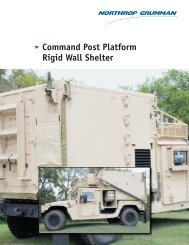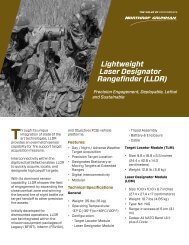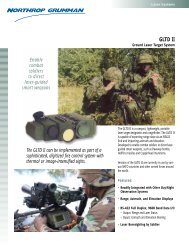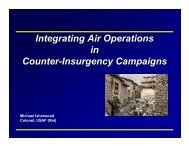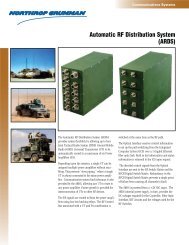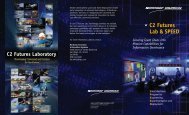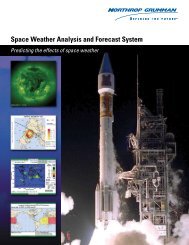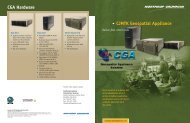Brochure - Northrop Grumman Corporation
Brochure - Northrop Grumman Corporation
Brochure - Northrop Grumman Corporation
You also want an ePaper? Increase the reach of your titles
YUMPU automatically turns print PDFs into web optimized ePapers that Google loves.
Extensive ECCM Features<br />
The S-Band AN/TPS-78 and TPS-703<br />
radars employ numerous advanced<br />
techniques to limit susceptibility to<br />
jamming. In a wartime mode, both radars<br />
operate in a frequency agile mode,<br />
dynamically selecting the least jammed<br />
frequency in the 300 MHz operating<br />
band. The operator can also select a<br />
fixed frequency for a peacetime mode<br />
to maintain bandwidth capability security.<br />
The low-sidelobe antenna will filter<br />
out most sidelobe jamming before it<br />
enters the radar system.<br />
Rank-ordered Constant False Alarm<br />
Rate (CFAR) is used to prevent false<br />
alarms from the small amount of residual<br />
interference that makes it through<br />
the low-sidelobe antenna. The rankordered<br />
CFAR eliminates false alarms<br />
with a minimum loss of detectability<br />
while providing resolution of closely<br />
spaced targets. Detection of small targets<br />
in weather and chaff is ensured by<br />
the stacked beam architecture, which<br />
provides the required multiple returns<br />
on each target for Doppler processing<br />
and impulse interference rejection.<br />
The narrow beam widths of the S-<br />
Band antenna reduce the amount of<br />
clutter competing with the targets,<br />
which helps target detection in clutter.<br />
Survivability<br />
The AN/TPS-78 and TPS-703 radars<br />
are designed and proven to operate<br />
in some of the world’s harshest, most<br />
unforgiving environments. This outstanding<br />
survivability is achieved by<br />
combining unsurpassed mobility, unmatched<br />
sidelobe levels and innovative<br />
“cool” antenna technology.<br />
Anti Radiation Missiles (ARM) use<br />
sidelobe technology to lock onto sensors,<br />
but the low-sidelobe antenna helps<br />
further protect from such attacks. There<br />
are no active radiating elements on the<br />
antenna, which provides a “cool” array<br />
to shield from the attacks of heat-seeking<br />
missiles.<br />
With a significantly lower weight and<br />
smaller size than the rest of their class,<br />
the AN/TPS-78 and TPS-703 are the<br />
best options when dealing with challenging<br />
conditions. The radars can be<br />
quickly transported to different locations<br />
as needed.<br />
Low-Cost Logistic<br />
Supportability<br />
Modular design reduces<br />
sparing requirements<br />
The modular design in the AN/TPS-78<br />
and TPS-703 systems reduce the number<br />
of transmitter Line Replaceable<br />
Unit (LRU) types by 80 percent from<br />
previous radar designs. The entire transmitter<br />
requires only nine different LRU<br />
types, including fully interchangeable<br />
pre-amps, power panels, and radio frequency<br />
panel power amplifier modules.<br />
The programmable processing architecture<br />
of the AN/TPS-78 and TPS-703<br />
reduce the number of processor LRU<br />
types by 90 percent, with only two basic<br />
circuit card styles needed for the<br />
signal and data processor suite.<br />
Leveraging system commonality<br />
Designing the AN/TPS-78 and the<br />
TPS-703 from the same system architecture<br />
assures that their respective<br />
mission requirements can be met with<br />
a high degree of operational, training<br />
and logistic commonality. This provides<br />
maximum returns on acquisition<br />
as well as operation and maintenance<br />
(O&M) investments. There is a greater<br />
than 90 percent commonality of major<br />
subsystems and LRUs between the AN/<br />
TPS-78 and TPS-703.<br />
The two radars also offer more than 90<br />
percent software commonality, so that<br />
software maintenance, modification<br />
and documentation costs are significantly<br />
below those of competing systems.<br />
The software is hosted on open-architecture<br />
signal and data processors, enabling<br />
cost-effective future upgrades.<br />
3<br />
Highly Reliable and<br />
Maintainable System<br />
Integrated redundancy and<br />
fault tolerant design<br />
The radars offer a mean time between<br />
critical failure rate (MTBCF) of over<br />
2,000 hours, greatly increasing the<br />
time between required maintenance actions.<br />
This excellent system availability<br />
is achieved through a combination<br />
of numerous factors. Redundancy integrated<br />
throughout the systems allows<br />
automatic reconfiguration after a fault<br />
condition, preserving full operational<br />
capability. Additionally, the design<br />
margin in the solid-state transmitter<br />
permits fault-tolerant operation meeting<br />
specified performance. Module replacement<br />
can be done at any time or<br />
during planned preventive maintenance<br />
intervals. Moreover, the environmentally<br />
controlled shelter maintains many<br />
of the electronics in a benign operating<br />
environment, significantly increasing<br />
hardware reliability.<br />
Maintenance is easily performed in an<br />
environmentally controlled shelter interior.<br />
Automated setup and<br />
unattended operation<br />
After initial system setup, full performance<br />
is maintained through the use<br />
of automatic calibration and Automatic<br />
Gain Control (AGC) functions, eliminating<br />
the need for subsequent operator<br />
actions. Automatic calibration enables<br />
full performance to be continued during<br />
unattended operation.


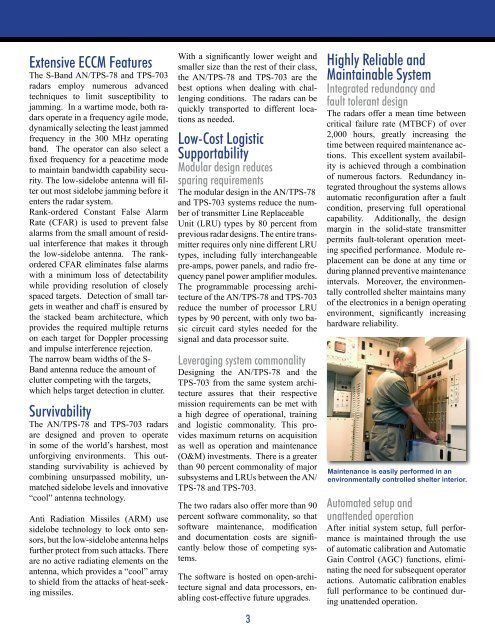
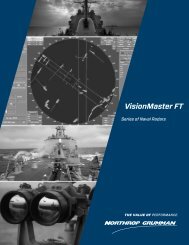
![[x] amendment of solicitation/modification of contract - Northrop ...](https://img.yumpu.com/51622731/1/190x245/x-amendment-of-solicitation-modification-of-contract-northrop-.jpg?quality=85)
